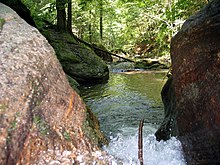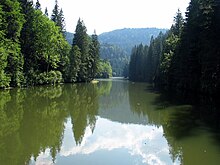Sankt Martin am Wöllmißberg
|
Sankt Martin am Wöllmißberg
|
||
|---|---|---|
| coat of arms | Austria map | |
|
|
||
| Basic data | ||
| Country: | Austria | |
| State : | Styria | |
| Political District : | Voitsberg | |
| License plate : | VO | |
| Surface: | 25.76 km² | |
| Coordinates : | 47 ° 0 ′ N , 15 ° 7 ′ E | |
| Height : | 704 m above sea level A. | |
| Residents : | 818 (January 1, 2020) | |
| Postal code : | 8580 | |
| Area code : | 03140 | |
| Community code : | 6 16 21 | |
| NUTS region | AT225 | |
| Address of the municipal administration: |
St. Martin a. W. 64 8580 Sankt Martin am Wöllmißberg |
|
| Website: | ||
| politics | ||
| Mayor : | Johann Hansbauer ( ÖVP ) | |
|
Municipal Council : (2015) (9 members) |
||
| Location of Sankt Martin am Wöllmißberg in the Voitsberg district | ||
| Source: Municipal data from Statistics Austria | ||
St. Martin am Wöllmißberg is a municipality with 818 inhabitants (as of January 1, 2020) in Styria in Austria .
geography
Geographical location
St. Martin is located at an altitude of 704 m south of Köflach and Voitsberg .
The municipality includes the Wöllmißberg ( 791 m ) located between the Gößnitzbach and the Teigitsch , as well as part of the Schusterbauerkogel ( 1288 m ) south of it . Most of the municipality is covered by coniferous forests and meadows.
Community structure
The municipality includes the following three localities (population in brackets as of January 1, 2020):
- Grosswöllmiß (186)
- Kleinwöllmiß (333)
- Sankt Martin am Wöllmißberg (299)
The community consists of three cadastral communities :
- Großwöllmiß, Kleinwöllmiß and St. Martin
and covers an area of 25.76 km².
Neighboring communities
| Köflach | Rosental an der Kainach , Voitsberg | Voitsberg |
| Precious scrap |

|
Krottendorf-Gaisfeld , league player |
| Precious scrap | Precious scrap | Ligist |
St. Martin does not border on St. Stefan ob Stainz , because south of St. Martin a narrow strip of territory of the Edelschrott municipality borders the Ligist municipality with approx. 70 m.
Culture and sights
- Anton Wildgans Memorial: was created in 1996 by sculptor Alfred Schlosser in honor of the poet Anton Wildgans, who began his epic “ Kirbisch ” in 1925 here
- Local history museum: started in 1965 for the 700th anniversary as a private initiative, and then officially redesigned in 1995 and housed in the former elementary school. Above all, the construction of the Langmannsperre and the Arnstein hydroelectric power station is documented here. In addition to the weavers' guild , household items, tools, school utensils and traditional costumes are also on display. A small exhibition is also dedicated to Anton Wildgans and Rochus Kohlbach , who were connected to St. Martin am Wöllmißberg
- Neu-Leonroth castle ruins at the foot of the Wöllmißberg
- The Teigitsch Gorge (about five kilometers) is the name given to the course of the Teigitsch between Gaisfeld in the municipality of Krottendorf-Gaisfeld via the municipality of Sankt Martin am Wöllmißberg to the Langmannsperre in the municipality of Edelschrott . The Teigitschgraben, embedded in the western Styrian low mountain range, can be reached via Packer Strasse B 70 or from the south autobahn A2 (Steinberg exit). Due to the abundance of water from the Koralm, the Teigitsch is not only of interest for tourism , but also for the energy industry . The oldest Styrian hydropower plants are located on this river. Thanks to the League of Nations loan, the Langmann lock for the Arnstein power plant was built in the early 1920s. In its day it was one of the most modern Austrian hydropower plants, as it was operated with a water column pressure that had not yet been achieved. After the Second World War, the 50 m high Hirzmannsperre located further up was built. The Packer reservoir is even further up . All the water that flows in the Teigitschgraben today comes from small tributaries on the right and left of the trench. The water from the upper reaches of the Langmann reservoir is diverted into a pipe system. As a result, the gorge lost a large part of its water volume from yesteryear and thus lost its tourist attractiveness. There were once three inns in Graben, none of which are open anymore. One was converted into a scout home (Ferienheim Langmannsperre). The core of the trench between the Arnstein power station and the Langmannsperre can be hiked in about 2.5 hours. At times, the hike leads along the water-carrying pipe and the so-called rail road, a level roadway on which Hunten transported the material for the construction of the Langmann barrier, which was brought up from the Arnstein power plant with an inclined elevator. Mineralogically, the Teigitschgraben, as it is located in the area of the crystalline rocks of the Styrian peripheral mountains between Soboth and Koralm, was an excellent find spot for various minerals such as rock crystals, smoky quartz, sphenes, feldspars and similar fissure minerals during the power plant construction. The discovery of the lichen-forming tube fungus Baeomyces rufus is biologically remarkable .
- Two popular folk music waltzes have the once wonderful Teigitschklamm in their name, the "Teigitschgraben waltz" and the "s'Diandl von Teigitsch".
- The Hans Kloepfer circular hiking trail leads through the municipality .
Economy and Infrastructure
The most important branch of the economy is the agricultural sector, especially forestry and dairy farming. There are also smaller commercial and tourism businesses.
The St. Martin cave power station with an output of 11 MW, which was built in 1965, and the Langmannsperre are located on the Teigitsch .
Together with Edelschrott and Hirschegg-Pack, the municipality forms the “Styrian Backpacking Villages” tourist association.
traffic
The A 2 southern motorway runs through the municipality .
Historical maps
- Historical maps of St. Martin and its surroundings from the three regional surveys from around 1789 to 1910
The area of St. Martin in the Josephinische Landesaufnahme , approx. 1789
St. Martin south of the Teigitsch in the Franziszeische Landesaufnahme , approx. 1835
Wöllmiss Berg (top center) in the Francisco-Josephine land survey , around 1910
North-west: Köflach, record sheet of the state survey around 1878
South: Stainz, Rosenkogel, Reinischkogel
politics
Local council election
The 2015 municipal council election showed the following result:
mayor
- since 2014 Johann Hansbauer (ÖVP)
coat of arms
The municipality's coat of arms shows a small chapel on a three-part hill, nestled between two fir trees. A gray ax is embedded in the green-colored hill itself.
Partner municipality
The partner community is the South Tyrolean village of Our Lady in the Forest .
Personalities
Honorary citizen
- 1979: Friedrich Niederl (1920–2012), Governor of Styria 1971–1980
Personalities associated with the community
- Anton Wildgans (1881–1932), poet and playwright
literature
- Ernst Lasnik: St. Martin am Wöllmißberg. St. Martin am Wöllmißberg 2007
Web links
- 61621 - Sankt Martin am Wöllmißberg. Community data, Statistics Austria .
- local community
- Sagen.at: How St. Martin am Wöllmisberg came about
- Description of the construction of the Neu-Leonroth castle ruins
Individual evidence
- ↑ Statistics Austria: Population on January 1st, 2020 by locality (area status on January 1st, 2020) , ( CSV )
- ↑ Hafellner, Josef: Remarkable lichen finds in Austria. 2001. Archived copy ( Memento of the original from May 25, 2014 in the Internet Archive ) Info: The archive link was inserted automatically and has not yet been checked. Please check the original and archive link according to the instructions and then remove this notice.
- ↑ Printed for example in: Teigitschgraben-Walzer. Folk way. Editing by Max Rosenzopf. In: Elke Margetich / Willibald Stelzl: School for Styrian Harmonica. I in notation. ISBN 3-901384-04-9 , page 48.
- ^ Grazer Zeitung , Official Gazette for Styria. December 30, 2014, 210th year, 52nd piece. ZDB -ID 1291268-2 p. 630.
- ↑ Elections. Retrieved January 28, 2020 .
- ^ Community of Sankt Martin am Wöllmißberg - local council. Retrieved January 28, 2020 .
- ^ Community of Sankt Martin am Wöllmißberg - partner community. Retrieved January 28, 2020 .
- ↑ Südost-Tagespost (February 10, 1979), p. 5.















